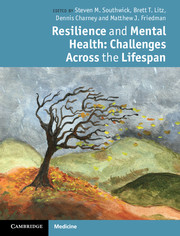Book contents
- Frontmatter
- Contents
- Contributors
- Preface
- Section 1 Pathways to resilience
- Section 2 Resilience across the lifespan
- Section 3 Resilience in families, communities, and societies
- Section 4 Specific challenges
- 13 Loss and grief: the role of individual differences
- 14 Reorienting resilience: adapting resilience for post-disaster research
- 15 Rape and other sexual assault
- 16 The stress continuum model: a military organizational approach to resilience and recovery
- 17 Resilience in the face of terrorism: linking resource investment with engagement
- 18 Resilience in the context of poverty
- 19 Resiliency in individuals with serious mental illness
- Section 5 Training for resilience
- Index
- References
15 - Rape and other sexual assault
from Section 4 - Specific challenges
Published online by Cambridge University Press: 07 September 2011
- Frontmatter
- Contents
- Contributors
- Preface
- Section 1 Pathways to resilience
- Section 2 Resilience across the lifespan
- Section 3 Resilience in families, communities, and societies
- Section 4 Specific challenges
- 13 Loss and grief: the role of individual differences
- 14 Reorienting resilience: adapting resilience for post-disaster research
- 15 Rape and other sexual assault
- 16 The stress continuum model: a military organizational approach to resilience and recovery
- 17 Resilience in the face of terrorism: linking resource investment with engagement
- 18 Resilience in the context of poverty
- 19 Resiliency in individuals with serious mental illness
- Section 5 Training for resilience
- Index
- References
Summary
Introduction
This chapter describes the prevalence of rape and the risk of associated mental health problems, including definition of key terms such as rape. The particular focus of the chapter is on post-traumatic stress disorder (PTSD) as a primary mental health problem associated with rape. Major methodological approaches to the study of rape, related risk, resilience, and associated mental health problems are described, and advantages and disadvantages and implications of the major approaches are discussed. Findings from the literature related to risk and protective factors for PTSD are reviewed in general, as well as what is known specifically about risk and protective factors for PTSD given exposure to rape. The discussion is concluded by considering the implications for future research related to etiology and/or intervention in relation to the study of resilience.
Prevalence of rape
Rape is a common problem in many countries, including America. Carefully conducted epidemiological studies estimate the proportion of women who have been raped is between 12.6% and 16.1% in the USA (Kilpatrick et al., 1992, 2007a; Tjaden & Thoennes, 2000). Based on the most recent estimates and the 2005 US Census data, an estimated 20.2 million women have been raped, with an estimated 1.1 million women who have been raped within a given year (Kilpatrick et al., 2007b). Furthermore, the incidence of rape is likely to be increasing, with recent lifetime prevalence estimates of rape being higher than those obtained in the early 1990s. There is substantial evidence to support significant untoward consequences of rape. Women who are victims of rape are at a significantly increased risk for mental health problems, substance abuse, and poor physical health compared with non-victims (Steketee & Foa, 1987; Resick, 1993; Resnick et al., 1993, 1997; Kessler et al., 1995; Kilpatrick et al., 1997, 2003). In particular, findings from epidemiological studies indicate that rape or completed sexual assault, compared with other traumatic events, is associated with greatest risk of PTSD (Kilpatrick et al., 1989; Norris, 1992; Resnick et al., 1993; Kessler et al., 1995). While estimates vary, approximately half of rape victims develop PTSD (Breslau et al., 1998); so not all women who experience rape develop emotional problems, but, given the high prevalence of rape and the substantial cost associated with this adverse event, it is not surprising that researchers have focused on predictors of PTSD among rape victims. A significant consequence of this focus is that little is understood about the characteristics of those who appear to endure rape with minimal adverse sequelae. A better understanding of the human capacity to maintain healthy, symptom-free functioning or resilience in the face of significant adversity is of great importance to the study of PTSD. It is useful to identify protective factors as well as risk factors for psychopathology, both to understand resilience in the face of known risk factors and to identify potentially modifiable risk factors that might be targeted in interventions promoting resilience (e.g., providing secondary prevention once a woman has been sexually assaulted). For example, knowing characteristics of rape that elevate risk may help to identify those who are resilient even under high-risk conditions and to identify individual, system response, or social response factors that produce more positive outcomes under those conditions. Consequently, the major objective of this chapter is to review what is known about risk and protective factors for PTSD after exposure to rape, with particular emphasis on factors related to resilience. Prior to this review, important terms will be defined and key methodological issues identified that should be considered in a review of rape and resilience and how well extant research is capable of providing information on resilience. Our review will draw on what existing reviews of the literature tell us about risk and protective factors for PTSD in general, as well as what we know about risk and protective factors for PTSD given exposure to rape specifically.
- Type
- Chapter
- Information
- Resilience and Mental HealthChallenges Across the Lifespan, pp. 218 - 237Publisher: Cambridge University PressPrint publication year: 2011
References
- 8
- Cited by

